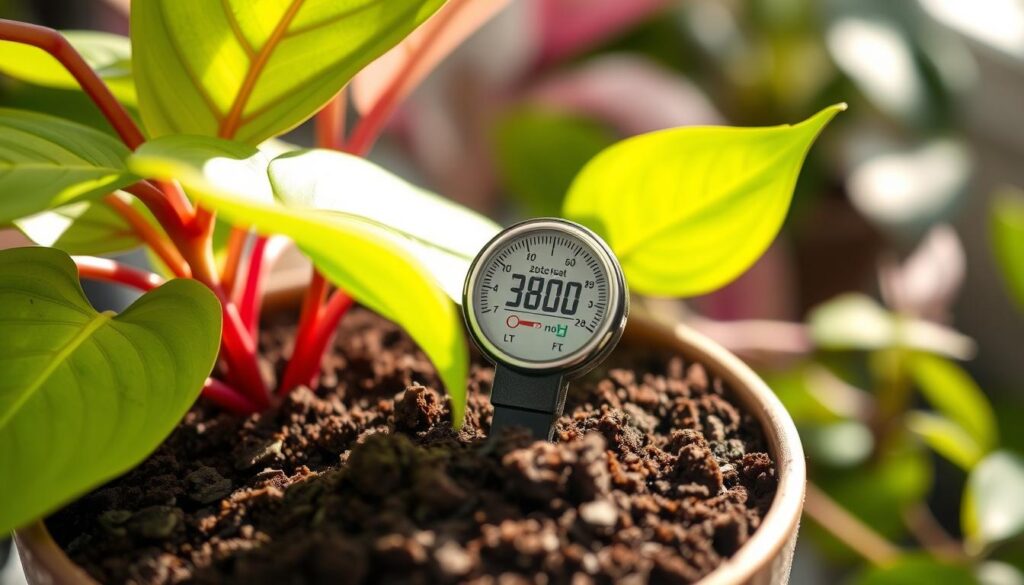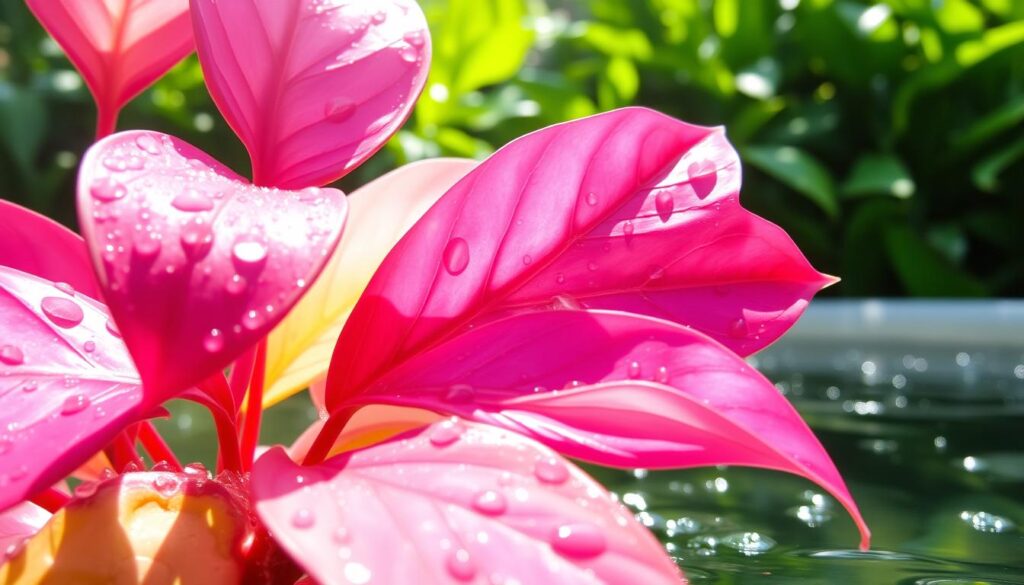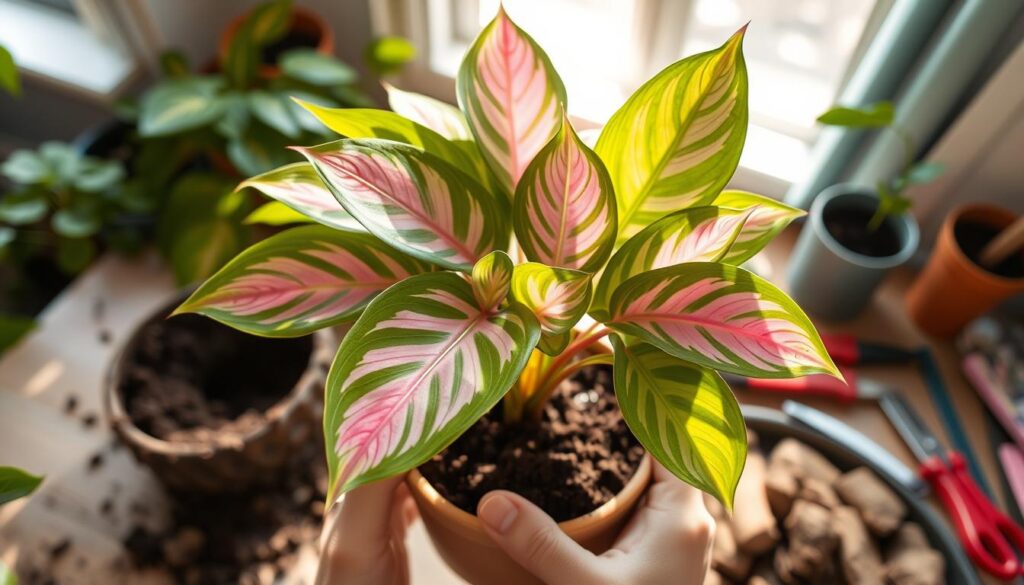The Pink Princess Philodendron is a top pick for plant lovers, thanks to Robert McColley from Florida. Its unique, pink and green leaves grab your eye. This plant loves the warmth and humidity of tropical rainforests, making it perfect for indoor spaces.
It needs bright, indirect light for 8 hours a day. The soil should drain well but still keep some moisture. Too much water can harm the roots, so let the soil dry a bit between waterings.
Key Takeaways
- The Pink Princess Philodendron is a stunning, tropical plant with vibrant pink and green variegated leaves.
- Proper watering is essential to maintain the plant’s health and prevent issues like root rot.
- Overwatering can be just as detrimental as underwatering, so it’s crucial to strike the right balance.
- This plant thrives in bright, indirect sunlight and well-draining soil that can hold some moisture.
- Understanding the plant’s watering needs and signs of over or underwatering can help ensure its long-term success.
What is a Pink Princess Philodendron?
The pink princess philodendron (Philodendron erubescens ‘pink princess’) is a stunning tropical houseplant. It comes from the rainforests of Colombia. Its leaves are deep green and heart-shaped, with a bubblegum pink variegation.
This plant is different from the Philodendron pink congo because its variegation stays the same. It’s a true showstopper with its unique color and tropical charm.
The pink princess philodendron loves bright, indirect light. It needs the right care to keep its stunning look. This includes proper watering, humidity, and fertilization.
| Characteristic | Description |
|---|---|
| Botanical Name | Philodendron erubescens ‘pink princess’ |
| Common Names | Pink Princess Philodendron, Blushing Philodendron |
| Plant Type | Tropical Houseplant |
| Foliage | Variegated green and pink leaves |
| Native Origin | Colombia, South America |
| Hardiness Zones | 9a to 11b |
The pink princess philodendron is a standout for indoor gardeners. Its variegated foliage and lush look make it a must-have. By knowing its needs, you can grow a thriving plant that will impress everyone.
“The pink princess philodendron is a must-have for any plant enthusiast looking to add a touch of tropical flair to their home.”
Importance of Proper Watering
Getting the watering right for your Pink Princess Philodendron is key to its health. Too much water can cause root rot, while too little can make the leaves wilted. Finding the right watering schedule is crucial for your plant’s well-being.
Overwatering vs. Underwatering
Too much water can turn your Pink Princess Philodendron’s leaves yellow and droopy. Not enough water can make them crispy and faded. It’s important to check the soil moisture often and adjust your watering as needed.
| Overwatering | Underwatering |
|---|---|
| Yellowing and drooping leaves | Crispy, wilted leaves |
| Mushy, rotting stems | Stunted growth |
| Increased risk of root rot | Washed-out, faded variegation |
By watching your Pink Princess Philodendron’s watering needs and adjusting, you can keep it healthy and colorful.

“Philodendrons come from a family of plants prone to root rot, so they like to dry out between waterings.”
Ideal Watering Schedule
Keeping the right watering schedule is key for your Pink Princess Philodendron’s health and growth. Unlike many houseplants, each Pink Princess Philodendron is different. The best watering schedule depends on soil type, light, and the plant’s stage of growth.
Water your Pink Princess Philodendron every 7-10 days. Let the soil dry out about 75% before watering again. Watch your plant closely and adjust the watering frequency as needed.
In the cooler fall and winter months, your plant needs less water. It’s in a dormant stage. But in the warmer spring and summer months, it grows more. You’ll need to water more often to keep the soil moist but not too wet.
| Season | Watering Frequency |
|---|---|
| Spring and Summer | Every 7-10 days |
| Fall and Winter | Every 10-14 days |
Understanding seasonal changes helps you adjust your watering schedule. This way, your Pink Princess Philodendron will thrive and keep its beautiful, variegated leaves.
“Maintaining the right balance of moisture is key to the long-term health and growth of your Pink Princess Philodendron.”
Checking Soil Moisture
Watering your pink princess philodendron right is key to its health and growth. It’s important to check the soil moisture regularly. The soil should dry out about 75% before you water it again. This prevents overwatering, which can cause root rot.
Using a Moisture Meter
Using a moisture meter is the best way to check soil moisture. This tool gives you a precise reading of the soil’s moisture level. It helps you know exactly when to water your pink princess philodendron, ensuring it gets the right amount of water.
- Moisture meters measure the soil’s moisture content, typically on a scale of 1 to 10 or 1 to 100.
- Insert the meter’s probe into the soil, taking readings at different depths to get a comprehensive understanding of the moisture level.
- Water your plant when the meter indicates the soil is dry, typically when the reading is in the 2-3 range.
With a moisture meter, you can easily figure out when to water your pink princess philodendron. This helps keep the soil moisture just right for your plant’s health and growth.

“A moisture meter is an essential tool for any plant enthusiast who wants to ensure their plants are getting the right amount of hydration.”
Bottom Watering Technique
For the Pink Princess Philodendron, bottom watering is a great method. It keeps the soil moist and helps the roots grow down. This also keeps fungus gnats away by not letting water reach the top of the soil.
To bottom water, put your plant in a bowl or tray with water. Let the soil soak up the water from the bottom. This way, the roots get the water they need without getting too wet.
| Watering Technique | Benefits |
|---|---|
| Bottom Watering |
|
| Self-Watering Pots |
|
Using self-watering pots is also a good idea. They keep the soil moist, especially when your plant is growing. This makes watering easier and keeps your plant healthy.
Remember, using bottom watering and self-watering pots can really help your Pink Princess Philodendron thrive.
Water Quality
When caring for your vibrant Pink Princess Philodendron, water quality is key. Experts say to use filtered water or tap water that has sat for 24 hours. This ensures your plant grows well and stays healthy.
Tap water can have chemicals and impurities harmful to your plant. Letting tap water sit for a day helps remove these. Or, you can use filtered water to keep your plant safe and hydrated.
Using the right water helps keep your Pink Princess looking its best. By focusing on water quality, your plant will thrive. It will be the talk of the town among plant lovers.
| Water Type | Recommended for Pink Princess Philodendron |
|---|---|
| Tap Water | Yes, if allowed to sit for 24 hours |
| Filtered Water | Yes, recommended for optimal plant health |

“By using filtered or properly treated tap water, you can ensure your Pink Princess Philodendron receives the high-quality hydration it needs to thrive.”
pink princess philodendron watering
Keeping a Pink Princess Philodendron looking vibrant and lush is all about the right watering. You should let the soil dry out about 75% before watering again. This usually happens every 7 to 10 days.
Checking the soil regularly is key. You can use your fingers or a moisture meter to see if it’s dry. When the top 2-3 centimeters feel dry, it’s time to water. It’s important to watch the soil closely because this plant doesn’t like too much or too little water.
Watering from the bottom is a great way to water your Pink Princess. Place the pot in a tray of water and let the soil soak up the moisture. This method helps prevent fungus gnats and promotes healthy roots.
| Watering Requirement | Frequency | Soil Moisture Level |
|---|---|---|
| Pink Princess Philodendron | Every 7-10 days | 75% dry |
To keep your plant looking its best, use filtered or sitting tap water. This helps avoid salt and mineral buildup that can harm the plant.
By following these tips, your Pink Princess Philodendron will stay healthy and beautiful. It will keep you amazed with its stunning leaves.
Signs of Overwatering
Overwatering is a common problem when caring for the stunning Pink Princess Philodendron. This plant can show signs of too much water, which can cause root rot if not fixed.
Yellowing and Drooping Leaves
Yellowing and drooping leaves are key signs of overwatering in Pink Princess Philodendrons. Leaves may also turn brown or show a yellow ring around them. These changes mean the plant is getting too much water.
If you see these signs, let the soil dry out before watering again. This helps prevent damage and keeps your plant healthy. Too much water can harm the roots and hurt the plant’s health.
| Overwatering Symptoms | Underwatering Symptoms |
|---|---|
| Yellowing leaves | Wilting, drooping leaves |
| Leaf discoloration | Crispy, brown leaves |
| Rapid wilting | Slow growth |
| Root rot | Soil that dries out quickly |
“Proper watering is essential for the long-term health and vibrant appearance of your Pink Princess Philodendron.”

Knowing the signs of overwatering helps keep your Pink Princess Philodendron healthy and beautiful. Check the soil moisture often and adjust your watering. This way, your plant will stay lush and vibrant in your home.
Signs of Underwatering
Underwatering can harm a Pink Princess Philodendron just like overwatering. Look for crispy, dried leaf edges. New leaves might also appear washed out or discolored, known as leaf curling.
Underwatered leaves can look wilted and droopy. It’s important to check the soil moisture. Water the plant when the top 75% of the soil is dry. Not watering enough can cause stunted growth and less vibrant leaves.
Maintaining Proper Soil Moisture
To avoid underwatering, create a regular watering schedule. The soil should be moist but not too wet. A moisture meter can help you know when to water, ensuring the right amount of water.
| Symptom | Cause | Solution |
|---|---|---|
| Crispy, dried leaf edges | Underwatering | Water the plant thoroughly when the top 75% of the soil is dry |
| Washed-out, discolored new leaves | Underwatering | Increase water frequency and ensure consistent soil moisture |
| Wilted, drooping leaves | Underwatering | Water the plant immediately and adjust watering schedule as needed |
By watching the soil moisture and acting fast, you can keep your Pink Princess Philodendrons healthy and vibrant.
Humidity Levels
The Pink Princess Philodendron loves humid places. It needs humidity between 65-80% to stay healthy and colorful. You can use a humidifier or a pebble tray to keep the air moist. Misting the leaves might attract pests and diseases.
Maintaining Proper Humidity
The best humidity for a Pink Princess Philodendron is 50-60%. This helps its leaves grow vibrant and green. If the leaves turn brown or droop, it’s a sign of trouble.
Using a hygrometer helps you check the humidity. Grouping plants together can also help keep the air moist. Warm air can hold more moisture, which is good for the plant.
There are many ways to keep the humidity right for your plant. You can use humidifiers, pebble trays, misting, or even sphagnum moss. If the humidity is too high, you can use dehumidifiers or ventilate the area.
Adjust the humidity based on the season. The Pink Princess Philodendron likes temperatures between 65-79 degrees Fahrenheit. Higher humidity helps with growth and keeps the leaves looking good.

Fertilizing Requirements
The Pink Princess Philodendron is a vibrant, variegated plant that needs careful fertilizing. It’s a tropical plant with special nutrient needs. To help it thrive, you must give it a balanced diet.
Feed your Pink Princess Philodendron a balanced liquid fertilizer every four to six weeks during the growing season. This season is from spring to early autumn. The fertilizer should have the right mix of nitrogen, phosphorus, and potassium (NPK). It should also have important micronutrients like calcium, magnesium, and sulfur.
Make sure to dilute the fertilizer to a quarter strength. This prevents the plant’s sensitive roots from getting burned. Philodendrons, including the Pink Princess, are very sensitive to too much fertilizer. This can cause yellow leaves, brown tips, and slow growth.
| Nutrient Requirement | Optimal Range |
|---|---|
| Nitrogen (N) | 10-20% |
| Phosphorus (P) | 5-10% |
| Potassium (K) | 5-10% |
| Calcium (Ca) | 2-4% |
| Magnesium (Mg) | 1-2% |
| Sulfur (S) | 1-2% |
The Pink Princess Philodendron has less chlorophyll and grows slower than solid green plants. It might need less fertilizer, but the right balance is still key. This keeps its colors bright and it healthy.
Stick to a consistent, balanced fertilizing plan. This will help your Pink Princess Philodendron grow well. It will keep showing off its stunning, unique leaves.
Repotting Guide
When to Repot
The Pink Princess Philodendron needs a new home every 1-2 years. Look for signs like roots coming out of the drainage holes. Or when the roots start circling inside the pot.
For repotting, pick a pot 2-4 inches bigger than the old one. Use a mix that drains well. Do this in spring or summer when the plant is growing fast. Water it well after to help it settle.
Choosing the right pot size is key for your plant’s health. Terracotta pots breathe well but need more water. Plastic pots hold water longer but don’t breathe as well. Self-watering and ceramic pots offer a good mix of function and style.
For help picking the perfect pot, check out Greg’s PlantVision. They can guide you and remind you of post-repotting care. This will help your Pink Princess Philodendron thrive in its new home.

| Pot Material | Moisture Retention | Breathability | Watering Frequency |
|---|---|---|---|
| Terracotta | Low | High | High |
| Plastic | High | Low | Low |
| Self-Watering | High | Moderate | Low |
| Ceramic | Moderate | Moderate | Moderate |
Common Issues and Solutions
The Pink Princess Philodendron faces many challenges, like pests, diseases, and leaf problems. It’s crucial to spot and fix these issues quickly. Knowing how to handle common problems helps your plant stay healthy and vibrant.
Pests and Diseases: Pests like mealybugs and aphids can harm your plant. Use neem oil or insecticidal soap to get rid of them. Root rot and fungal infections can also occur if you water too much. Fixing watering issues and ensuring good soil drainage can prevent these diseases.
Leaf Discoloration and Loss of Variegation: Yellow or brown leaves can mean several things. It might be due to bad lighting, not enough nutrients, or pests. Fixing these problems can make your leaves look great again.
Variegation loss is another issue. This can happen if the plant doesn’t get enough light. Make sure it gets 8 hours of indirect sunlight to keep its beautiful colors.
Leggy Growth and Other Issues: If your plant gets too long, it might not have enough light. Move it to a brighter spot or add extra lighting. This will help it grow bushy and healthy.
Fixing watering and nutrient problems can also solve growth issues. Stunted or deformed leaves often come from these problems.
By watching for and fixing problems early, your Pink Princess Philodendron will thrive. Enjoy its stunning foliage for many years.
“The key to maintaining a healthy Pink Princess Philodendron is staying on top of potential problems and making adjustments as needed. With the right care, this plant can be a stunning addition to any indoor space.”
Conclusion
The Philodendron Pink Princess is a stunning houseplant that has become very popular, especially in the UK. It’s loved by both experienced plant lovers and newbies. This plant is easy to care for and can grow well in different light conditions.
To keep the Philodendron Pink Princess looking its best, it’s important to follow the tips in this guide. You need to water it right, check the soil moisture, and give it the perfect environment. This includes the right amount of light, humidity, and temperature.
By following these care tips, you can enjoy the beauty of your Philodendron Pink Princess. It will become a highlight of your indoor plants. With proper pink princess philodendron care, it will be a rewarding addition to your houseplant maintenance routine. It shows how amazing tropical plants can be in our homes.


